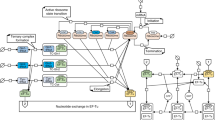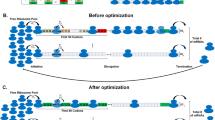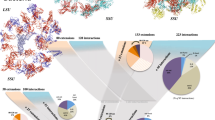Abstract
Many fine-scale features of ribosomes have been explained in terms of function, revealing a molecular machine that is optimized for error-correction, speed and control. Here we demonstrate mathematically that many less well understood, larger-scale features of ribosomes—such as why a few ribosomal RNA molecules dominate the mass and why the ribosomal protein content is divided into 55–80 small, similarly sized segments—speed up their autocatalytic production.
This is a preview of subscription content, access via your institution
Access options
Access Nature and 54 other Nature Portfolio journals
Get Nature+, our best-value online-access subscription
$29.99 / 30 days
cancel any time
Subscribe to this journal
Receive 51 print issues and online access
$199.00 per year
only $3.90 per issue
Buy this article
- Purchase on Springer Link
- Instant access to full article PDF
Prices may be subject to local taxes which are calculated during checkout




Similar content being viewed by others
References
Rodnina, M. V., Wintermeyer, W. & Green, R. Ribosomes Structure, Function, and Dynamics (Springer, 2011)
Milo, R., Jorgensen, P., Moran, U., Weber, G. & Springer, M. BioNumbers—the database of key numbers in molecular and cell biology. Nucleic Acids Res. 38 (Suppl.), D750–D753 (2010)
Dill, K. A., Ghosh, K. & Schmit, J. D. Physical limits of cells and proteomes. Proc. Natl Acad. Sci. USA 108, 17876–17882 (2011)
Klumpp, S., Scott, M., Pedersen, S. & Hwa, T. Molecular crowding limits translation and cell growth. Proc. Natl Acad. Sci. USA 110, 16754–16759 (2013)
Liebermeister, W. et al. Visual account of protein investment in cellular functions. Proc. Natl Acad. Sci. USA 111, 8488–8493 (2014)
Schaechter, M., Maaløe, O. & Kjeldgaard, N. O. Dependency on medium and temperature of cell size and chemical composition during balanced grown of Salmonella typhimurium. J. Gen. Microbiol. 19, 592–606 (1958)
Maaløe, O. An analysis of bacterial growth. Dev. Biol. Suppl. 3, 33–58 (1969)
Forchhammer, J. & Lindahl, L. Growth rate of polypeptide chains as a function of the cell growth rate in a mutant of Escherichia coli 15. J. Mol. Biol. 55, 563–568 (1971)
Ehrenberg, M. & Kurland, C. G. Costs of accuracy determined by a maximal growth rate constraint. Q. Rev. Biophys. 17, 45–82 (1984)
Bremer, H. & Dennis, P. P. Modulation of chemical composition and other parameters of the cell at different exponential growth rates. Ecosal Plus 3, http://doi.org/10.1128/ecosal.5.2.3 (2008)
Scott, M., Gunderson, C. W., Mateescu, E. M., Zhang, Z. & Hwa, T. Interdependence of cell growth and gene expression: origins and consequences. Science 330, 1099–1102 (2010)
Melnikov, S. et al. One core, two shells: bacterial and eukaryotic ribosomes. Nat. Struct. Mol. Biol. 19, 560–567 (2012)
Scott, M., Klumpp, S., Mateescu, E. M. & Hwa, T. Emergence of robust growth laws from optimal regulation of ribosome synthesis. Mol. Syst. Biol. 10, 747 (2014)
Maitra, A. & Dill, K. A. Bacterial growth laws reflect the evolutionary importance of energy efficiency. Proc. Natl Acad. Sci. USA 112, 406–411 (2015)
Maitra, A. & Dill, K. A. Modeling the overproduction of ribosomes when antibacterial drugs act on cells. Biophys. J. 110, 743–748 (2016)
Nomura, M., Gourse, R. & Baughman, G. Regulation of the synthesis of ribosomes and ribosomal components. Annu. Rev. Biochem. 53, 75–117 (1984)
Zengel, J. M. & Lindahl, L. Diverse mechanisms for regulating ribosomal protein synthesis in Escherichia coli. Prog. Nucleic Acid Res. Mol. Biol. 47, 331–370 (1994)
Yamamoto, H. et al. 70S-scanning initiation is a novel and frequent initiation mode of ribosomal translation in bacteria. Proc. Natl Acad. Sci. USA 113, E1180–E1189 (2016)
Li, G. W., Burkhardt, D., Gross, C. & Weissman, J. S. Quantifying absolute protein synthesis rates reveals principles underlying allocation of cellular resources. Cell 157, 624–635 (2014)
Brandt, F. et al. The native 3D organization of bacterial polysomes. Cell 136, 261–271 (2009)
UniProt Consortium. UniProt: a hub for protein information. Nucleic Acids Res. 43, D204–D212 (2015)
Sengupta, J., Agrawal, R. K. & Frank, J. Visualization of protein S1 within the 30S ribosomal subunit and its interaction with messenger RNA. Proc. Natl Acad. Sci. USA 98, 11991–11996 (2001)
Qu, X., Lancaster, L., Noller, H. F., Bustamante, C. & Tinoco, I. Jr. Ribosomal protein S1 unwinds double-stranded RNA in multiple steps. Proc. Natl Acad. Sci. USA 109, 14458–14463 (2012)
Sauert, M., Temmel, H. & Moll, I. Heterogeneity of the translational machinery: variations on a common theme. Biochimie 114, 39–47 (2015)
Cech, T. R. Evolution of biological catalysis: ribozyme to RNP enzyme. Cold Spring Harb. Symp. Quant. Biol. 74, 11–16 (2009)
Shajani, Z., Sykes, M. T. & Williamson, J. R. Assembly of bacterial ribosomes. Annu. Rev. Biochem. 80, 501–526 (2011)
Woolford, J. L. Jr & Baserga, S. J. Ribosome biogenesis in the yeast Saccharomyces cerevisiae. Genetics 195, 643–681 (2013)
O’Brien, T. W. Evolution of a protein-rich mitochondrial ribosome: implications for human genetic disease. Gene 286, 73–79 (2002)
Sharma, M. R. et al. Structure of the mammalian mitochondrial ribosome reveals an expanded functional role for its component proteins. Cell 115, 97–108 (2003)
Amunts, A. et al. Structure of the yeast mitochondrial large ribosomal subunit. Science 343, 1485–1489 (2014)
Greber, B. J. et al. Ribosome. The complete structure of the 55S mammalian mitochondrial ribosome. Science 348, 303–308 (2015)
Sagan, L. On the origin of mitosing cells. J. Theor. Biol. 14, 225–274 (1967)
Andersson, S. G. E. et al. The genome sequence of Rickettsia prowazekii and the origin of mitochondria. Nature 396, 133–140 (1998)
Myasnikov, A. G. et al. The molecular structure of the left-handed supra-molecular helix of eukaryotic polyribosomes. Nat. Commun. 5, 5294 (2014)
Acknowledgements
S.R. was supported by a James S. McDonnell Foundation fellowship. S.R. and J.P. were supported by NSF-DMS grant PD127334 and NIH grant R01GM095784. J.P. and M.E. were supported by HFSP grant RGP0042 and M.E. was further supported by the Swedish Research Council and the Wallenberg Foundation (RiboCORE). We are grateful to R. Ward, A. Hilfinger, R. Milo, R. Jajoo and M. Landon for discussions.
Author information
Authors and Affiliations
Contributions
S.R. and J.P. conceived the work, derived results and wrote the paper. M.E. contributed extensive advice and ideas.
Corresponding author
Ethics declarations
Competing interests
The authors declare no competing financial interests.
Additional information
Reviewer Information Nature thanks I. Golding, M. Oeffinger, S. Klumpp and the other anonymous reviewer(s) for their contribution to the peer review of this work.
Publisher's note: Springer Nature remains neutral with regard to jurisdictional claims in published maps and institutional affiliations.
Extended data figures and tables
Extended Data Figure 1 Stochastic production of individual r-proteins may not substantially limit efficiency in ribosome biogenesis.
a, Schematic of the way in which stochastic gene expression creates temporary shortages of some r-proteins and surpluses of others. The number of complete ribosomes assembled is then limited by the r-protein that is present in lowest abundance, and the average value of the difference between the minimum and the mean 〈Δ〉 is the mean number of unmatched r-proteins. b, The relative mean free r-protein pool (from a) increases very slowly with the number of ribosomal proteins n. For illustrative purposes we used negative binomial distributions with mean μ and different variances σ2 (Supplementary Information), because this distribution has been observed and predicted in many studies of stochastic gene expression. The inset shows a curve collapse for  . We obtained similar results for more complete kinetic models. c, The fraction of the r-protein mass in the form of nascent peptides or free pools arising from noisy expression (assuming Poisson noise for simplicity, but with similar results for many other noise models). There is technically an optimal number of r-proteins nopt, but the curves around and above this value are very shallow, meaning that there is practically no upper limit.
. We obtained similar results for more complete kinetic models. c, The fraction of the r-protein mass in the form of nascent peptides or free pools arising from noisy expression (assuming Poisson noise for simplicity, but with similar results for many other noise models). There is technically an optimal number of r-proteins nopt, but the curves around and above this value are very shallow, meaning that there is practically no upper limit.
Extended Data Figure 2 The r-proteins are statistical outliers in terms of size compared to the rest of the genome.
a, Distribution of the average protein length in 106 random samples of 56 proteins taken from the genome of E. coli; the mean length of a protein in the bacterial ribosome is also marked (inset ribosome with arrow). The probability of generating an average protein length as small as that seen in the bacterial ribosome is vanishingly small (at most 10−17). b, The Chernoff upper bound (Supplementary Information) on the probability that the average length of r-proteins could arise at random, that is, with no size selection, is computed for: 104 archaea (orange), 1,248 bacteria (blue) and 74 eukarya (green). The value for E. coli is 10−17 (see a); vanishingly small probabilities are attributed to all organisms that we examined.
Extended Data Figure 3 The r-proteins are unusually similar to each other in size even when conditioning on the average size.
Cumulative frequency of  for randomly generated protein complexes of varying numbers of proteins is shown. See Supplementary Information for details. a, b, Only complexes in which the average protein length is identical (±5 amino acids) to that seen in the ribosomes of E. coli (a) and S. cerevisiae (b) entered the statistics. As the number of proteins in a complex gradually increases from 2 to the number of proteins in the ribosome—55 in E. coli (protein S1 was excluded; see main text) and 79 in S. cerevisiae—the occurrence of coefficients of variation (CVL) as low as those seen for the set of r-proteins becomes extremely rare.
for randomly generated protein complexes of varying numbers of proteins is shown. See Supplementary Information for details. a, b, Only complexes in which the average protein length is identical (±5 amino acids) to that seen in the ribosomes of E. coli (a) and S. cerevisiae (b) entered the statistics. As the number of proteins in a complex gradually increases from 2 to the number of proteins in the ribosome—55 in E. coli (protein S1 was excluded; see main text) and 79 in S. cerevisiae—the occurrence of coefficients of variation (CVL) as low as those seen for the set of r-proteins becomes extremely rare.
Extended Data Figure 4 Differences between different types of ribosomes are qualitatively as expected from considering efficiency in their biogenesis.
Bacterial ribosomes contain about 55 r-proteins (blue) that average about 130 amino acids and make up 30%–35% of the ribosome mass. Eukaryotic ribosomes contain about 80 r-proteins (blue) that average about 165 amino acids and make up about 45% of the ribosome mass. In both these cases, ribosomes catalyse their own production. By contrast, in mitochondrial ribosomes, which do not produce themselves, rRNA (grey) is more scarce and r-proteins are much larger, making up as much as 80% of the ribosome mass.
Supplementary information
Supplementary Information
This file contains Supplementary Text and Data – see contents page for details. (PDF 420 kb)
Supplementary Data
This file contains a list of proteomes. (XLSX 26 kb)
Rights and permissions
About this article
Cite this article
Reuveni, S., Ehrenberg, M. & Paulsson, J. Ribosomes are optimized for autocatalytic production. Nature 547, 293–297 (2017). https://doi.org/10.1038/nature22998
Received:
Accepted:
Published:
Issue Date:
DOI: https://doi.org/10.1038/nature22998
This article is cited by
-
Costs of ribosomal RNA stabilization affect ribosome composition at maximum growth rate
Communications Biology (2024)
-
Ribosome Abundance Control in Prokaryotes
Bulletin of Mathematical Biology (2023)
-
Supramolecular assembly of protein building blocks: from folding to function
Nano Convergence (2022)
-
Role of main RNA modifications in cancer: N6-methyladenosine, 5-methylcytosine, and pseudouridine
Signal Transduction and Targeted Therapy (2022)
-
\({\text{COSNet}}_i\): ComplexOme-Structural Network Interpreter used to study spatial enrichment in metazoan ribosomes
BMC Bioinformatics (2021)
Comments
By submitting a comment you agree to abide by our Terms and Community Guidelines. If you find something abusive or that does not comply with our terms or guidelines please flag it as inappropriate.



